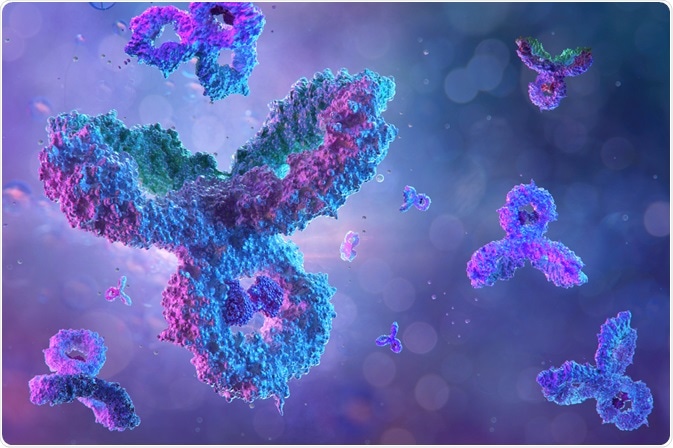Biosensors provide vital information about the presence and quantity of a particular substance. Their use spans environmental monitoring, food quality control, and the biomedical fields. Two well-known examples of biosensing in medicine are pregnancy tests and glucose monitoring.
Biosensors can be based on the use of a variety of different molecules including enzymes, DNA, and antibodies. The most used bioreceptors in biosensors are antibodies. Antibodies are well adapted to this use because of their natural selectivity.
What is a biosensor?
Biosensor applications
Biosensors are devices designed to detect the presence and quantity of a particular molecule. Each biosensor has to be individually designed for a molecule of interest. They can also be designed to be in either one point in time, a ‘single shot’ sensor, or over some time, ‘long term monitoring’, depending on the need of the biosensor.
Both types of biosensors are illustrated in the development of insulin monitoring. The traditional finger prick test is an example of a single-shot biosensor, whereas the more modern, continuous glucose monitor is an example of a ‘long-term monitoring’ biosensor.
How biosensors work
There are five distinct stages to a biosensor. Firstly, there is the analyte, which is the target substance of interest. This analyte is recognized by the bioreceptor, a molecule that selectively binds the analyte.
Next, there is the transducer which converts the bio-recognition into a measurable signal. Then there is the electronics stage, which prepares the signal for display, leading to the final display stage, presenting the information in a manner that that allows user interpretation.
Biosensor considerations
As a complicated process, there are many considerations that go into designing a biosensor. The major areas of consideration are reproducibility, how reliably the system generates responses; stability, how susceptible the system is to ambient disturbances; sensitivity, the minimum amount of analyte that can be detected by the biosensor; and finally, selectivity, how specific bioreceptor is for the analyte.
What are antibodies?
Antibodies naturally select certain biomolecules. They are y-shaped proteins produced by plasma cells that are an essential part of the immune system. Antibodies identify pathogens by selectively binding to their membrane, thereby targeting the immune system towards them.
Each antibody will only bind to one particular substrate. Although there are different types of antibodies in the immune system they are all selectively bound molecules.
Antibodies as bioreceptors
The selectivity of antibodies lends them to being used as bioreceptors in biosensors. The adoption of antibodies into biosensors has facilitated the creation of in vivo biosensors. Classically, in antibody biosensors, the antibody bioreceptors are immobilized on the surface of the transducer. This is then exposed to the solution containing the analyte.
The binding of the analyte to the antibody bioreceptor causes the transducer to convert the bio-recognition into a signal.

Antibodies. Image Credit: Corona Borealis Studio/Shutterstock.com
Scaffolding Antibodies
How the antibodies are attached to the transducer can affect the detection limit and sensitivity of the biosensor. There are four different methods: random non-covalent, random covalent, orientated via the binding site, and orientated via an additional binding molecule.
The best scaffolding method varies according to the requirement for each antibody biosensor, however, the aim is identical, to achieve the most densely packed antibodies without affecting their confirmation and analyte binding ability. Both random methods of attaching the antibodies lead to a less consistent packing, reducing the detection limit of the biosensor.
Whereas orientated methods rely on the interaction between the surface and the tail of the antibody. This option often depends on cysteine residues in the tail of the antibody which is easier to manipulate if the antibody is recombinant.
Production of Antibodies
The origin of the antibodies used in biosensors also affects the outcome of the biosensor. There are three major antibody types: polyclonal, monoclonal, or recombinant. Polyclonal antibodies are purified through screening with an antiserum against the specific target. This leads to non-homogeneous antibodies.
In cases where it is important to have homogeneous antibodies, monoclonal antibodies are produced by the fusion of the antibody-producing plasma cells to immortal myeloma cells. These are screened for the cells producing the desired antibody and cloned until all the cells produce the desired antibody.
In contrast, recombinant antibodies are produced differently. They are purified from modified bacteria. Many of these recombinant antibodies are purified in aggregate and require refolding. However, the use of recombinant antibodies allows for greater control over the produced antibody. This can allow the antibody tail to be designed to incorporate amino acids that interact with metals in the sensor scaffolding.
Conclusion
Biosensors have a pivotal role in identifying the presence and quantity of target molecules. Their use across many different disciplines demonstrates this however they have to be carefully designed for different uses. Antibodies are suited to being bioreceptors within the biosensor.
Antibodies selectively bind molecules and can be manipulated into a binding particular target molecule. They can be produced to do this through either screening or recombinant production but they must be carefully placed onto the transducer scaffold in such a way that it does not affect the selectivity of the molecule. With all considerations in biosensor design antibodies, biosensors are the most popular of the biological biosensor designs.
References:
- Bhalla, N., Jolly, P., Formisano, N., & Estrela, P. (2016). Introduction to biosensors. Essays in Biochemistry, 60, 1–8. https://doi.org/10.1042/EBC20150001
- Byrne, B., Stack, E., Gilmartin, N., & O’Kennedy, R. (2009). Antibody-based sensors: Principles, problems, and potential for detection of pathogens and associated toxins. Sensors, 9, 4407–4445. https://doi.org/10.3390/s90604407
- Dzantiev, B., & Zherdev, A. (2013). Antibody-Based Biosensors. October, 161–196. https://doi.org/10.1201/b15589-7
- Mollarasouli, F., Kurbanoglu, S., & Ozkan, S. A. (2019). The role of electrochemical immunosensors in clinical analysis. Biosensors, 9(3), 1–19. https://doi.org/10.3390/bios9030086
- Sharma, S., Byrne, H., & O’Kennedy, R. J. (2016). Antibodies and antibody-derived analytical biosensors. Essays in Biochemistry, 60, 9–18. https://doi.org/10.1042/EBC20150002
- Zeng, X., Shen, Z., & Mernaugh, R. (2011). Recombinant antibodies and their use in biosensors. Analytical and Bioanalytical Chemistry, 402(10), 3027–3038. https://doi.org/10.1007/s00216-011-5569-z
Further Reading
Last Updated: Jan 20, 2021